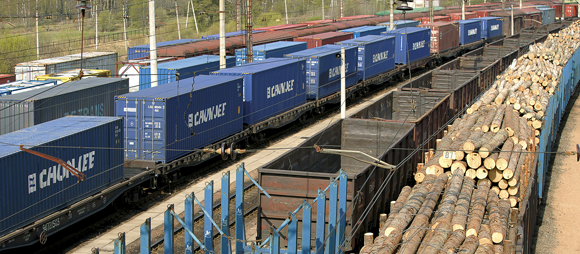Service functions
-
Download center
-
Add to My Report
-
My Report (0)
-
Print this Page
-
Download in PDF
-
Share
-
Feedback
-
Interactive analysis
-
Browsing history
-
Offline version
-
Company in soc.networks
-
Compared to 2011
-
Popular pages
-
Company on the map
-
Compact view
| Enter e-mail recipient * | Your e-mail * | Comment : | |
| * required fields | |||
Freight Turnover

Freight turnover is the most accurate indicator of infrastructure load and Company performance. In 2012, the indicator increased by 4.4%, reaching its highest peak in the entire history of the Russian Federation.
In 2012, freight turnover of JSC “RZD” (excluding empty cars of other owners and leased cars) exceeded the indicator of the pre-crisis year of 2007 by 6.3% and exceeded the level of 1992 by 13%.
In 1992, loading volumes exceeded the volumes of 2012 by 21%. Today, JSC “RZD” is operating in the areas of peak processing loads.
- Major trends
- Freight turnover and railway loading volumes are growing and have exceeded the pre-crisis level
- Freight traffic destinations remain focused on Russian ports
- Freight turnover growth rate outperforms loading growth rate
- State tariff regulation remains in place
Freight turnover on electrified lines (by 1992) increased 26%, and on diesel lines (whichnormally run latitudinally), halved, which is evidence of the extremely high load imbalance of the infrastructure.
The highest gain in freight turnover has typically been seen in eastern railways — from Krasnoyarsk to the Far East. Here, freight turnover has increased 5.7% versus 2011 and 32% versus 2007.
Recently, freight turnover growth rate has overtaken the loading growth rate. These trends are first and foremost determined by the freight transportation distance, which has reached its historical peak: 1,546 kilometers (1.5 times higher than in 1992), which is due to changes in economic conditions and growth in export transportation.
Freight traffic destinations continue to focus on Russian ports. Consequently, the load factor of a number of sections has reached its peak and the management of an unhindered train service will require large-scale infrastructure investments.
Since 2003, when JSC “RZD” was incorporated, transportation to the ports of the Azov and Black Sea basin has increased by 41%, and to North West and Far East ports 2.1 times. This positive trend in transportation has not been affected at all by a decline in economic growth.
Increase in freight turnover in the domestic market in 2012 was lower (+2.3%) than in the international market (+6.2%).
Freight turnover net (monthly) trends, bln t-km
Monthly net freight turnover trends compared to pre-crisis level (% versus relevant month of 2007)
The structure of freight turnover has undergone minor changes. The share of transportation within Russia decreased from 45% to 44.1%; correspondingly, the share of international transportation increased to 55.9%.
Changes in the freight turnover structure are related both to an increased volume of export transportation and its distance: the share of export transportation in the total freight transportation volume increased to 48.4% (+0.8 p.p.).
 Address of the President
Address of the President
 175th Anniversary of Russian Railways
175th Anniversary of Russian Railways
 Analysis
Analysis
 Save Key Indicators to XLS
Save Key Indicators to XLS
 Transport Development Strategy
Transport Development Strategy
 Investment Activity
Investment Activity
 Download Chapter Financial and Economic Performance
Download Chapter Financial and Economic Performance
 Rating
Rating
 Loan Portfolio
Loan Portfolio
 Management System
Management System
 Governing Structure Of JSC Russian Railways
Governing Structure Of JSC Russian Railways
 Personnel management
Personnel management
 Housing policy
Housing policy